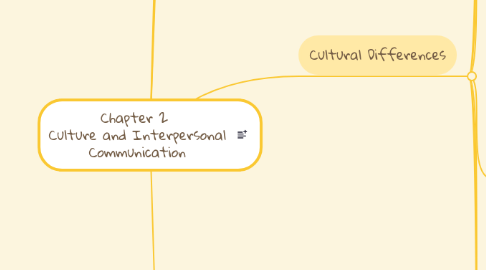
1. Nature of culture
1.1. Values
1.2. Beliefs
1.3. Artifacts
1.4. Language
1.5. Art
1.6. Laws
1.7. Religion
1.8. Communication theories
1.9. Styles
1.10. Attitude
1.11. Gender
1.12. Enculturation
1.13. Ethnic Identity
1.14. Acculturation
2. The Relevance of Culture
2.1. Demographic Changes
2.2. Sensitivity to Cultural Differences
2.3. Economic Interdependence
2.4. Spread of Technology
2.5. Culture-Specific Nature of Interpersonal Communication
3. The Aim of a Cultural Perspective
3.1. Universal vs. Relative
3.2. Situations Vary
3.3. Not All Practices are Equal or Acceptable
4. Cultural Differences
4.1. Individualist or collectivist orientation
4.1.1. Individualist- teaches members the importance of individual values such as power, achievement, hedonism, and stimulation.
4.1.1.1. United States
4.1.1.2. Australia
4.1.1.3. United Kingdom
4.1.1.4. Netherlands
4.1.1.5. Canada
4.1.1.6. New Zealand
4.1.1.7. Italy
4.1.1.8. Belgium
4.1.1.9. Denmark
4.1.1.10. Sweden
4.1.2. Collectivist- teaches members the importance of group values such as benevolence, tradition, and conformity.
4.1.2.1. Guetamala
4.1.2.2. Ecuador
4.1.2.3. Panama
4.1.2.4. Venezuela
4.1.2.5. Colombia
4.1.2.6. Indonesia
4.1.2.7. Pakistan
4.1.2.8. China
4.1.2.9. Costa Rica
4.1.2.10. Peru
4.2. Emphasis on context
4.2.1. high
4.2.1.1. Power Concentrated in Hand of Few
4.2.1.1.1. Mexico
4.2.1.1.2. Brazil
4.2.1.1.3. India
4.2.1.1.4. Philippines
4.2.2. low
4.2.2.1. Power More Evenly Distributed
4.2.2.1.1. Denmark
4.2.2.1.2. Sweden
4.2.2.1.3. New Zealand
4.3. Power Distance
4.3.1. refers to how power is distributed in a society
4.3.1.1. High power distance cultures
4.3.1.1.1. Malaysia
4.3.1.1.2. Slovakia
4.3.1.1.3. Guatemala
4.3.1.1.4. Panama
4.3.1.1.5. Philippines
4.3.1.1.6. Rusia
4.3.1.1.7. Romania
4.3.1.1.8. Serbia
4.3.1.1.9. Suriname
4.3.1.1.10. Mexico
4.3.1.2. Low power distance cultures
4.3.1.2.1. Austria
4.3.1.2.2. Israel
4.3.1.2.3. Denmark
4.3.1.2.4. New Zealand
4.3.1.2.5. Switzerland
4.3.1.2.6. Ireland
4.3.1.2.7. Sweden
4.3.1.2.8. Norway
4.3.1.2.9. Finland
4.3.1.2.10. Great Britain
4.4. Masculinity-femininity
4.4.1. Self-concept
4.4.1.1. Masculinity
4.4.1.1.1. Aggressiveness
4.4.1.1.2. Material success
4.4.1.1.3. Strength
4.4.1.2. Femininity
4.4.1.2.1. Modesty
4.4.1.2.2. Concern for relationships
4.4.1.2.3. The quality of life
4.4.1.2.4. Tenderness
4.5. Tolerance for ambiguity
4.5.1. High Ambiguity Tolerant
4.5.1.1. Don't feel threatened by unknown situations
4.5.1.2. Uncertainty is a normal part of life, and people accept it as it comes
4.5.1.3. Singapore, Jamaica, Denmark, Sweden, Hong Kong, Ireland, Great Britain, Malaysia, India, Philippines and United States
4.5.1.4. Comfortable with ambiguity and uncertainty
4.5.1.5. Minimize the importance of rules governing communication and relationships
4.5.2. Low Ambiguity Tolerant
4.5.2.1. Avoid uncertainty
4.5.2.2. Have a great deal of anxiety about not knowing that will happen next
4.5.2.3. See uncertainty as threatening and as something that must be counteracted
4.5.2.4. Greece, Portugal, Guatemala, Uruguay, Belgium, Malta, Russia, El Salvador, Poland, and Japan
4.5.2.5. Create clear-cut rules for communication that must not be broken
4.6. Long and short term orientation
4.6.1. Long-term orientation
4.6.1.1. Promotes the importance of future rewards
4.6.1.2. Values
4.6.1.2.1. Hard work
4.6.1.2.2. Respect of learning
4.6.1.2.3. Honesty
4.6.1.2.4. Openness to new ideas
4.6.1.2.5. Accountability
4.6.1.2.6. Self-discipline
4.6.2. Short-term orientation
4.6.2.1. Look more to the past and the present
4.6.2.2. Look to profits in the future
4.6.2.3. Values
4.6.2.3.1. Freedom of expression
4.6.2.3.2. Personal freedom
4.6.2.3.3. Self-reliance
4.6.2.3.4. Individual rights
4.6.2.3.5. Hard work
4.6.2.3.6. Personal achievement
4.7. Indulgence and restraint
4.7.1. Indulgence
4.7.1.1. Emphasize the gratification of desires
4.7.1.2. Focus on having fun and enjoying life
4.7.1.3. Two major factors
4.7.1.3.1. Life control
4.7.1.3.2. Leisure
4.7.2. Restraint
4.7.2.1. On the other hand, are those that foster the curbing of such gratification and its regulation by social norms
4.7.2.2. More people who are unhappy
4.7.2.3. More cynical, pessimistic, and less likely to remember positive emotions
5. Principles for Effective Intercultural Communication
5.1. Communication between persons who have different cultural beliefs, values, or ways of behaving
5.1.1. Communication between cultures
5.1.2. Communication between races
5.1.3. Communication between people of different religious
5.1.4. Communication between smaller cultures existing within the larger culture
5.1.5. Communication between nations
5.1.6. Communication between genders
5.2. Cultural sensitivity - an attitude and way of behaving in which you're aware of and acknowledge cultural differences,
5.2.1. Increasing Cultural Sensitivity
5.2.1.1. Prepare yourself
5.2.1.2. Recognize differences
5.2.1.3. Recognize differences within the group
5.2.1.4. Recognize differences in meaning
5.2.1.5. Be rule conscious
5.3. Culture Shock
5.3.1. Stage 1
5.3.1.1. The Honeymoon
5.3.2. Stage 2
5.3.2.1. The Crisis
5.3.3. Stage 3
5.3.3.1. The Recovery
5.3.4. Stage 4
5.3.4.1. The Adjustment
5.4. Between people with and without Disabilities
5.4.1. people with disabilities
5.4.1.1. Communicate your feelings
5.4.1.2. Be patient and understanding
5.4.1.3. Demonstrate your own comfort
5.4.2. People without disabilities
5.4.2.1. Use person-first language where the person, rather than the disability is emphasized
5.4.2.2. Respect assistive devices, such as wheelchairs, canes, walkers, or crutches
5.4.2.3. Shake hands with person with the disability if you shake hands with others in a group
5.4.2.4. Avoid talking about the person with a disability in the third person
5.4.2.5. Don't assume that people who have a disability are intellectually impaired
5.4.2.6. When you're not sure how to act, ask
5.4.2.7. Maintain similar eye level
